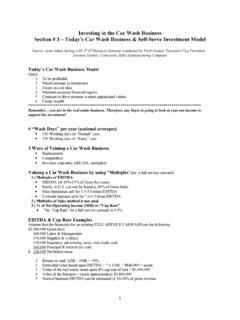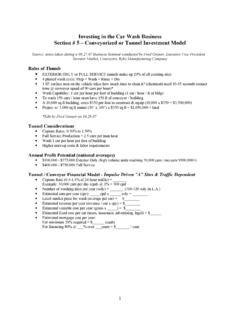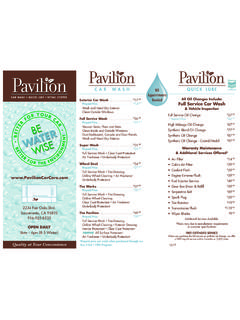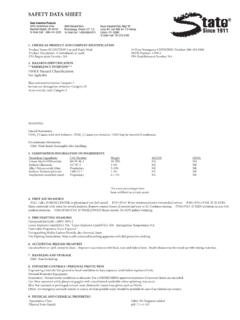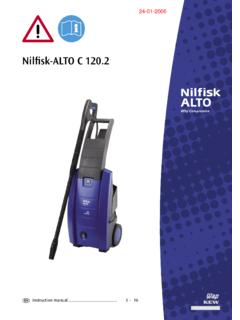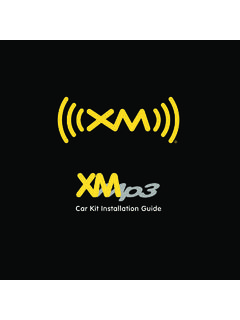Transcription of Detailing Your Classic - Home | My Classic Car with …
1 Detailing your Classic A great designer once said, "Beauty is in the details." Concours car show winners know what he meant. Detailing makes the difference between winning and losing. Here are some secrets: Get Under It Detailing should be done from the bottom up. You begin at the chassis and finish with the paintwork and upholstery. The idea is to do the dirtiest work first. Cleaning a chassis that has been on the road for years is a filthy, time consuming job, but competition at shows is pretty intense. You can bet the other guys running gear will be sanitary enough to eat off of. So put on your grubby attire, eye protection and rubberized work gloves and start cleaning it up. Getting Started Many people take their car to a steam cleaner or blast their chassis with a pressure gun at a do-it-yourself car wash. Such devices will remove a lot of muck quickly but will also blow dirty water into all kinds of other places.
2 It shouldn't be in areas such as the ignition system, crevices in the body work, or even the upholstery panels and paint. It is safer to clean things by hand. It is hard work, but the results are much better, and you don't run the risk of damaging irreplaceable parts. Grab your scrapers, wire brush and solvent and roll under the car. Caked on grime can be removed with the sharpened scraper. Soften stubborn, hard-to-get, greasy dirt with the squirt can and solvent. Let it soak in for a few minutes, then scrub it with a wire brush. Next, mix a strong solution of dishwasher detergent and water in a bucket ( works well too). Then scrub as much of the chassis as you can with a stiff bristle brush. Especially filthy areas can benefit by slopping on plenty of solution. For added punch, you can shake some powdered laundry detergent into it. Let the stuff set for a few minutes so the chemicals in the soap will have time to do their job, then scrub the area again.
3 Rinse thoroughly afterwards, and don't get any of the wash solution on your skin. It's surprisingly caustic. Prep It Brush off any loose rust with a wire brush. Then get things as clean as possible with your electric drill and a wire brush disk. Use a sanding pad on broad, flat areas. On many cars, it will not be possible to get to a few areas up in the suspension, but make every effort to get as close as possible while cleaning to remove as much of the grease and rust as you can. Figure 1 Caked-on grunge can be scraped off with a sharp putty knife. Figure 2 Using a wire wheel and drill to clean your car's chassis is safer than sand blasting. Paint It Those of us that are ambitious enough to do frame-off restorations on cars that are trailered to and from shows can bead blast chassis components to perfect cleanliness, and then paint them with DuPont Imron.
4 Most home restorers who like to use their cars don't want to go to that extreme. Rustoleum or Eastwood's chassis black is the best alternative. They have the correct semi-gloss appearance like the paint most manufacturers used originally, and Rustoleum does not require a completely rust-free surface to adhere properly. Begin the task by covering tires and other areas that could be affected by overspray with plastic tarps or newspaper. Shoot your undercarriage using aerosol cans or a compressor and a touch-up gun. Use pieces of cardboard as shields where necessary. Shoot on a couple of coats of rusty metal primer and let it dry for a day or two. Then shoot on the top coats. Some parts of the running gear and suspension will have to be painted colors other than black. Shock absorbers came in a lot of different colors at different times throughout automotive history.
5 Try to match the original color of yours. Also, transmissions were often painted the same color as the engine. Use the correct color of engine enamel, or Eastwood's cast iron paint, to give yours that factory fresh look. Engine Room Rescue In order to compete at shows, your engine compartment must be more than clean. It must look showroom new. Not only must things be painted the correct colors, but ignition wires, hoses, clamps and fan belts must be correct and new looking. Engine accessories must be clean and freshly painted. These are things you would do as a matter of course if you are doing a complete restoration, but they can also be done with the engine in the car if you're Detailing for competition. Cleaning an engine is much like doing the undercarriage except you are standing up. Use the same tools and techniques as you did with the chassis.
6 Before you get started, there is some disassembly work to be done. Take off the Accessories Remove all of the engine accessories so you can clean and paint them, and so you can detail the block. Attach clothes pins to the ignition wires, numbered according to the cylinders they go to. Then remove the distributor. Disconnect the battery at its terminals. Then use more clothes pins or tape to tag wires that go to the starter and generator. Now remove these items, along with any pumps, carburetors, air filters, fans, pulleys and any other items that will get in the way of painting the block. Wrap the wire harness with plastic trash bags and masking tape to keep it dry and free of paint overspray. Finally, loosen exhaust manifolds and pull them away from the engine. Scrub It Place duct tape over any holes in the block to seal them from moisture.
7 Then scrub the engine clean of dirt and grease. Use the detergent solution and a scrub brush as well as the solvent can if necessary. Finally, wash the engine down with a good degreaser such as Eastwood's PRE. Paint It Scuff any painted areas with #360 grit sandpaper. Use a metal-prep etching solution or naval jelly to etch any bare metal areas. Now mist on a very light tack coat of the engine enamel, let it get sticky, then shoot on two or three finish coats. Let each coat dry before applying the next. In case you're wondering, no primer is used with most engine paint. Engine enamels, high temperature coatings for manifolds, and specialty paints are available from The Eastwood Company. Order one of their catalogs so you can see the selection by going to Coat the Manifolds Use only high temperature coatings for the manifolds that will take 1000 degrees Fahrenheit without burning off.
8 Before shooting them, clean them to bright metal with a hand drill and a wire wheel. Use new gaskets when you re-attach your manifolds to the block. Clean and Paint the Accessories Scour the fan, pulleys, radiator tanks, generator or alternator, starter, distributor and pumps until free of dirt and rust. Then wipe them down with PRE and scuff them with sandpaper. Shoot them with Eastwood's Under Hood Black or Rustoleum. Many restoration shops use Rustoleum for the chassis as well as engine accessories because it holds up well, is easy to apply and it has the correct semi-gloss sheen. Put it Back Together As necessary, clean and paint all nuts and bolts that hold your engine together. Then reinstall all of the accessories. Replace any incorrect or worn hoses, hose clamps, belts or ignition wires with new ones. Use new gaskets where required.
9 Finally, apply new decals where they are supposed to go. They are usually available from the club for your marque. Now stand back and admire your work. Tough Buffing If it is not too thin to be polished, your car's paintwork can be restored to its original shine and depth with a bit of work and care. I learned auto Detailing from a pro named Percy who plied his trade behind a local car wash back in the '50s. Used car dealers in our area relied on Percy's expertise to make their inventory irresistible to buyers. Here is what he taught me. Rub It Out Paint that is oxidized and flat can be restored to its original luster using ordinary rubbing compound. The pros use power buffers and special concoctions that can get the job done quickly. Unless you are proficient with buffers, you can just do your car by hand. A buffer in inexperienced hands can burn right through paint and ruin a finish that could otherwise be saved.
10 Other things to remember, even when polishing by hand, are as follows. Go lightly on tops, hoods and tops of fenders. Chances are the paint will be most worn in these spots, so such areas will require a light touch to avoid cutting through to primer. Never rub the sharp edges of the hood, doors or other panels. The paint in these areas is thin (even when new), and it buffs off to bare metal in a hurry. Remove any brightwork or chrome items that can be taken off easily. If there is an automotive paint store near you, buy professional quality rubbing compound and polish from them. Otherwise, the products available at your local auto supply will do. Follow directions on the container. They usually recommend that you work a small area (2 feet by 2 feet). Use a soft cloth that is folded into a pad and slightly dampened. Work with your hand flat, and do a circular or cross-hatch pattern so your fingers won't make grooves in the finish.

